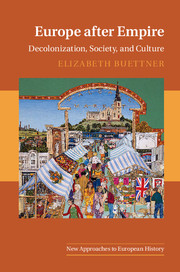Book contents
- Frontmatter
- Contents
- List of figures
- Acknowledgements
- Introduction
- Part I Decolonization for colonizers: Europe's transition to the postcolonial era
- Part II Migrations and multiculturalisms in postcolonial Europe
- Part III Memories, legacies, and further directions
- Epilogue: thoughts towards new histories of contemporary Europe
- Bibliography
- Index
Epilogue: thoughts towards new histories of contemporary Europe
Published online by Cambridge University Press: 05 June 2016
- Frontmatter
- Contents
- List of figures
- Acknowledgements
- Introduction
- Part I Decolonization for colonizers: Europe's transition to the postcolonial era
- Part II Migrations and multiculturalisms in postcolonial Europe
- Part III Memories, legacies, and further directions
- Epilogue: thoughts towards new histories of contemporary Europe
- Bibliography
- Index
Summary
In June 2004 on the Hobbemaplein, a small square in The Hague, members of the Netherlands’ Indo-Surinamese community proudly unveiled a two-part monument to their collective history of colonial and postcolonial migrations. Despite its chosen name, the National Hindustani Immigration Monument (Nationaal Hindustaans Immigratiemonument) was in fact much more than national. It commemorated a history of two uprootings and resettlements that stretched from indentured labourers’ departure from colonial British India for what was then Dutch Guiana (Suriname) starting in 1873 to the mass Indo-Surinamese migration to the Netherlands in the decolonization era a century later. Three decades on and with a substantial proportion having clustered in and around the city, the Indo-Surinamese had become ‘Hindoestaanse Hagenaars’, or ‘Hindustanis of The Hague’. One bronze sculpture designed by a Surinamese artist featured boats, airplanes, sacks, and suitcases on one side and people in transit on its reverse to depict the two phases of intercontinental migration. Several meters away stood a statue of Mohandas Gandhi, an inspirational migrant himself given his own journeys from Gujarat to Victorian London as a student, to South Africa as a lawyer and activist who fought for Indian diasporic rights, and back to India where he achieved global acclaim as the foremost Indian nationalist who campaigned for independence by non-violent means.
The monument's two components thereby invoked a heritage that greatly exceeded the confines of the Netherlands and its ex-colony in South America to incorporate British South Asia and South Africa, rendering it trans-imperial as much as it was emblematic of (ex-)metropolitan-colonial population flows. Designed by a Dutch artist of Portuguese descent, moreover, the Gandhi sculpture also provided indirect testament to the intra-European movements and diasporas that complemented those coming from Europe's former colonies. On The Hague's Hobbemaplein, the local, national, continental, and intercontinental converged, with the global not reducible to one former European empire alone. And as Indo-Surinamese celebrated their successful re-rooting, socio-economic progress, and cultural adaptation in the Netherlands without having forsaken their roots, their guests of honour endorsed their presence and transition. Together with the city's mayor, the Dutch Minister for Integration congratulated them with the words ‘U doet het goed’, or ‘You're doing well’ – a far cry from the relentless level of public concern then being expressed about other migrant groups who were Muslim as opposed to predominantly Hindu.
- Type
- Chapter
- Information
- Europe after EmpireDecolonization, Society, and Culture, pp. 491 - 504Publisher: Cambridge University PressPrint publication year: 2016



